First, a message from your friendly (excuse the pun) neighbor-hood Totoro, as an apology for the bomb I’m about to drop on you.
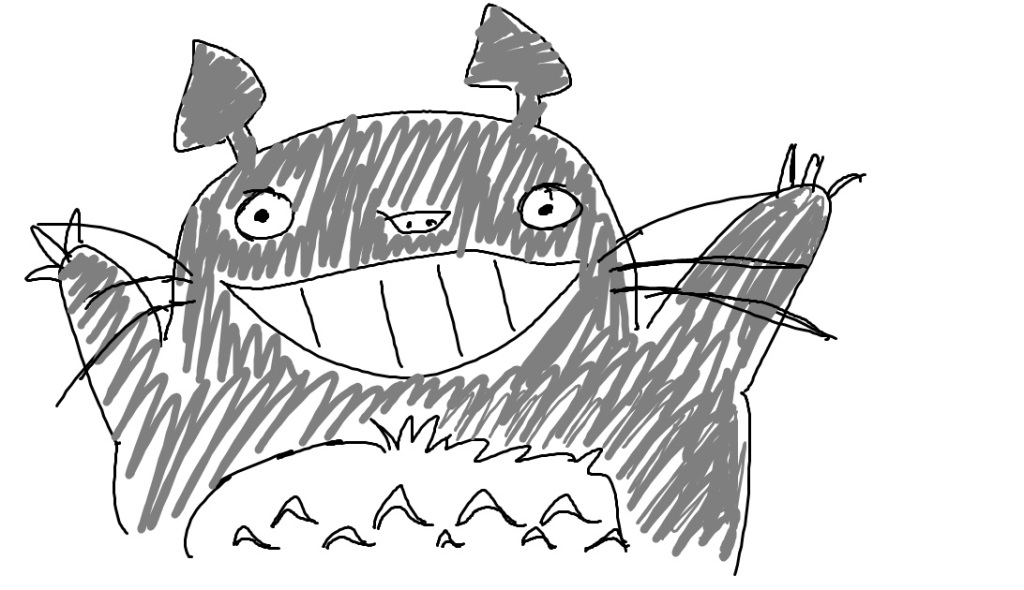
More things I have learned today: A tablet computer does not an artist make. Art by me.
In my apartment, Totoro is a frequent topic of discussion. I kind of assume that Totoro is a frequent topic of discussion in households everywhere, but just in case he isn’t, I would like to impart some wisdom upon which this discussion has recently stumbled: Totoro has some dark-ass roots.
I wish I were talking about his hair color here, but I am not. In fact, there are two different origin stories that I’ve been researching obsessively since I heard about them, attempting desperately to prove that My Neighbor Totoro, the film that brought Totoro into existence, is nothing more than a really adorable movie about some really adorable kids and their really adorable forest-spirit friends.
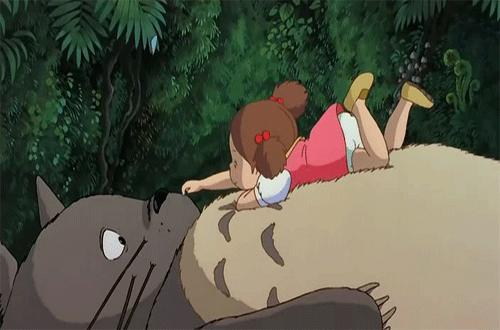
Unfortunately, I have learned two new… let’s call them origin stories, for lack of a better term… that would argue the contrary. In order to keep you from seriously going off the deep end, I will present them in a two part post — one today, one tomorrow, that reveals some of the darker edges around Totoro’s furry belly.
Part One: “The Sayama Case” or “Are Mei and Satsuki dead?”
My roommate came home the other day and told me a story he had heard from a classmate who happens to be from Japan. “So My Neighbor Totoro is apparently based on a real-life murder case of two little girls, and Totoro is supposed to be a spirit of death.” Well, we live in the age of the internet, so my instant reaction was to google “Totoro based on a true story”. Go ahead, google it. Back?
At the time of writing this article, that search garnered 645,000 results. The sources are from all over the world, in English as well as Japanese, and stories range from “MIYAZAKI WROTE TOTORO AS A MESSAGE OF DEATH” all the way to “Well, isn’t this quite the coincidence **wink wink**” In order to save you some time and offer you what I think is the best explanation, I have broken my findings into two sections:
The Case
The Sayama Incident refers to the details surrounding a 1963 murder case which took place in Sayama City, Japan, 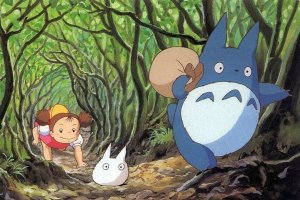 wherein a teenage girl named Yoshie Nakata was kidnapped and later found dead. While a man was eventually convicted of the murder, many sources still contest his guilt in the case. Kazuo Ishikawa, the man arrested, is a member of the Buraku minority, which is often discriminated against because of their status as laborers. Most of the information online about the Sayama Incident is split into two categories: sites contesting Ishikawa’s guilt, and those relating the case to Totoro.
wherein a teenage girl named Yoshie Nakata was kidnapped and later found dead. While a man was eventually convicted of the murder, many sources still contest his guilt in the case. Kazuo Ishikawa, the man arrested, is a member of the Buraku minority, which is often discriminated against because of their status as laborers. Most of the information online about the Sayama Incident is split into two categories: sites contesting Ishikawa’s guilt, and those relating the case to Totoro.
There are some reports that Yoshie’s sister, after finding her body, returned home driven crazy by the sight of her murdered sibling. Others state that the family, which included three boys and two other girls, was being raised by a single father while their mother was hospitalized for a brain tumor. If these facts were true, and I can not verify nor deny them with any certainty, then they would certainly strengthen the case for Miyazaki drawing inspiration from the Sayama Incident. Without these facts, however, the ties are loose where they do exist.
The Theory
What most of these theories boil down to is this: Totoro is a harbinger of death. Mei dies first, like Yoshie in the Sayama Incident, and when Satsuki goes looking for her sister, her own meeting with Totoro dooms her as well. Adding to this idea are the theories that the movie is told in a non-linear fashion and that the girls die early on. The final scene is supposed to be a flashback to the beginning of the movie, before their mother was checked into the hospital. Furthermore, the scene where the girls and the troupe of Totoros create the giant tree in their backyard and sit in its branches, their father is actually writing a story about his children who have already died. As he imagines the story, he sees it manifest outside his window.

According to certain Totoro fan sites, when Yoshie’s sister returned from finding her body in the woods, she was rambling about a raccoon creature, and a cat monster, which inspired both Totoro and the Cat Bus. I have not been able to find any factual reports or exact quotes. Instead, I have found other, more plausible explanations of both Catbus and Totoro’s origins. The catbus is definitely inspired by the Japanese legend of the Bake-neko, or a cat which has gained magical powers to transform and transport the dead into the after-life. and Totoro is in some part based on Japanese racoons or Tanukis–with or without the tragic insanity of Yoshie’s sister.
The only part of the theory that I believe holds water in relation to catbus is the fact that, once Sataskui sets out to find her sister, his destination changes simply to “Mei” rather than a real location. This might indicate that Mei is nowhere in this world, and in order to find her they will have to traverse over to where she can be found.
While watching the movie again yesterday, I’m not sure how much of the theory I actually believe, although if the
translations and other cultural explanations on my.opera.com are accurate, I might be more willing to see the sinister side of a movie that otherwise just makes me smile. Granny’s character can see Mei and Satsuki long after Mei runs into the forest the first time, and Kanta (who we prefer to call the Maytag man) continues to interact with them while they wait in the rain.
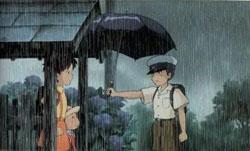
Miyazaki’s comments on the film have also run contrary to elements of this theory. While some argue that the statues sitting behind Mei while she is lost are indicators of her death, Miyazaki has explained that they were actually spirits which he used to illustrate the fact that she is safe and will find her way home.
While there are definitely similarities between the the Sayama Incident and elements of Totoro, without more hard evidence or comments from the filmmakers I don’t know that there’s enough of a case to actually claim that the movie is entirely based on the real-life events. The next theory, regardless of which version you want to believe, is incontestably tragic and very real.
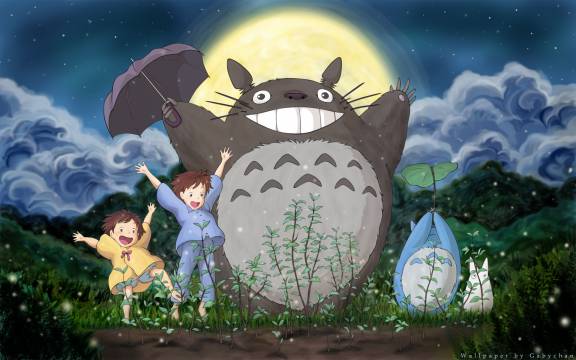
Don’t forget to check out Two New Ways to Watch Totoro (You Won’t Like Either One): Part Two, when I will share with you the saddest origin story you ever did hear. (Hint: It has to do with the end of World War II. From the Japanese perspective.)




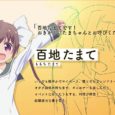

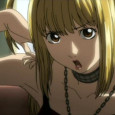








This is an interesting theory. I’d heard this before, but you sum it up pretty well. I find this way of thinking of the movie more bitter-sweet rather than sad, depressing, or disturbing. When put in the context of the Sayama Case, the movie suggests that even though what happened was horrible, that there is still hope after death- an important idea after such a case.
Interesting! I hadn’t thought of that, thanks for the analysis! I love how people are continuing to comment, almost a year after I put this article up. Glad you enjoyed reading :D
Excellent article.
One thing that’s bugged me since watching Totoro was that, despite the creature having all these extraordinary abilities, he doesn’t do a darn thing to help the children with their mother’s recovery! At most, he shows them their mother in the hospital (?). Oh, great — and if they took the local bus, they could have actually *visited* their mother or something.
But this now makes sense with the death god theory. In pretty much all literature with a death god, the death god has extraordinary abilities, yet all he (or she!) does is ferry the now dead being to the afterlife, typically after helping the now dead cope with the idea that they’re dead. And, iirc, when a death god takes a child to the afterlife, he will (surprise, surprise) *play with* the children, as children otherwise are unable to understand and therefore accept death in the same way as adults do.
I should mention that on an occasional geek forum, a thread will appear with an “alternate interpretation”, typically dark, of an otherwise cheery animation or other story. Heard of the Rugrats one? :)
Anyway, feel free to drop me a line at my email addy if you have a reply.
I too just recently came to the dark underbelly of Totoro, having watched it for the first time tonight.
I won’t attempt here to substantiate the argument of origins in the Sayama case, though I find those coincidences very interesting. Rather, I want to support the fact that this movie unequivocally draws connections between Mei and Satsuki, Totoro, and death. The connections I’d like to touch upon are consistently neglected in sites detailing with these Totoro ‘urban legends’ despite the degree to which they constitute, in my viewing anyway, the most tangible proof for reading Totoro as, if not the ‘god of death,’ some sort of supernatural being associated very closely with it.
This evidence comes when Satsuki is looking for Mei. She goes into the darkness of the tree (which itself is suggestive as a passage into death) to find Totori and ask him for his help. Mei is lost, she reports. Earlier in the movie, too, we were told that Mei has a tendency to get lost (迷子). Where did she go? That’s really the question here.
Totori helps Satsuki by putting her on the cat-bus. The destination reel spins . For those who can read Japanese, it is clear that all of the names that appear are associated with 2 things: 1) bodies of water; 2) death. As for 1) for example, we read ‘marsh’, ‘swamp’, and ‘pond’. That these names hint at the body of water into which Mei was believed to have fallen, and in which a large group of villagers desperately search for her, cannot easily be denied. 2) though is more interesting. Others have often mentioned “grave road,” one of the names that appears, important because it hints at death. Somehow, however, the other two place names do not often get included in their analysis. Both of these use the character for tumulus, or grave mound, tsuka 塚. Swamps, marshes, ponds, graves, and tumuli… and then Mei.
Well where is Mei? Where else but crying aside six standing Jizō bosatsu figures ! For scholars of religion the significance here is overwhelmingly obvious. You often find Jizō statues in groups of six at grave sites. I should rephrase this. If you find six statues of Jizō (or as individuals for that matter), you are close to a grave. Why? Because Jizō is the bodhisattva believed to be able to freely move from one realm of rebirth to the next (much like Kannon). In Buddhist cosmology there are six realms of rebirth: hell, hungry ghosts, animals, asuras, humans, and deva. Jizō is thus presented in six to indicate his ability to move in between any of these worlds; he is a bodhisattva and his job is to save you no matter what terrible rebirth you ended up in. Because of this role in helping those who get lost between the worlds of transmigration after they die, Jizō statues are often placed at crossroads and forks in the road. Such statues appear throughout the film itself: Mei and Satsuki take refuge from the rain together with a Jizō statue and Satsuki even gives a prayer to him. That Jizō would appear so much in other senses only reinforces the resonances we find in this one where Mei is lost.
Rather than read Totoro as a “scary” “god of death,” it is much more appropriate to read him as Jizō. Totoro doesn’t kill or bring death to anyone. Accidents, perhaps murders?, drowning, does that. Totoro helps Satsuki find her sister who is lost between the transition points of death. This is precisely the role that Jizō plays: he transports you up and down and whenever you need to go to find your lost mother or lover and do what you can to make sure they are able to achieve salvation.
There are a couple other important points here.
1. The 8th month August. That is when Mei and Satsuki visit their mom and look at her from a distance in the tree with catbus, where he mom says that she has a feeling that she could see them there. [Just look at the calendar behind the mother during this scene]. The 8th month is significant in Japan (and throughout all East Asia) as the month when ghosts are wandering around and lost. This is the month where ghosts come back from wherever they ended up (the hells for example) to visit the home, eat the offerings given to them, make peace, only to go back to the underworlds again. The festival and rituals carried out during this month for the dead are called o-bon. I do not think it is an exaggeration to say that every Japanese knows about this festival and what spirits are doing during this month, which is why during the summer you get the “halloweeny” shows that we normally have in October in America.
2. The reproductive ritual. Remember the scene where Mei and Satsuki wake up to go help Totoro perform the ritual that causes the trees to grow? Some people have denied the idea that Totoro is a god of death by pointing out his relation to fecundity here, his ability to make the plants grow, and thus his association with life. Thus, as I’ve said, he’s most assuredly not a god of death. But he is a god of earth, in some form. And earth is both reproduction and destructive: earth is fundamentally ambivalent. Thus we should not be surprised that Totoro has two seemingly contradictory associations here.
But in making this point, haven’t I thrown out the idea that Totoro is Jizo bosatsu? Not exactly: Jizo means literally the “womb” or “storehouse” 蔵 of the “earth” 地. Jizo thus also has these ambivalent associations: while on the one hand he is associated with death in Japan (and China), on the other hand, (and this is probably only true for Japan), he is strongly associated with fecundity, especially the reproductive power whereby one makes children ! (And thus you have the reverse association as well: he becomes associated with infants who have passed on and the mizukokuyō rites). So this still fits with the idea of Totoro as Jizō.
3. The lending of an umbrella. This is such an important aspect of the story that it is strange to think no one else has mentioned it. There are two important umbrella exchanges: 1) Satsuki gives the umbrella to Totoro when they are at the Inari-mae bus stop; 2) the boy gives Satsuki the umbrella while she is waiting out the rain next to the Jizō statue. The connections might already be clear: In a sense, the boy is offering the umbrella to her (the main, obvious point) but from another perspective the offering is to Jizo, since she is standing directly within his shrine (it’s a roofed shrine space for Jizo and not technically a bus stop or anything–you see these throughout Japan). Both can possibly be read as offerings to Jizo.
But what’s up with offering umbrellas to Jizo? In fact, this is an established trope in popular religious tales that are, like the o-bon festival, also known throughout Japan. I won’t get into all of the details, but there is one story where an old man who comes across a row of Jizo’s in the rain offers them umbrella hats out of his compassion. He is rewarded for his offering with food at his front door step the next day. The point is: offerings are made to Jizo, Jizo does something in your favor–and often this means that Jizo will lead you to other worlds to help you find loved ones in trouble. This is precisely what happens in the film: offerings are made to Jizo, and he helps Satsuki to find Mei. While this lending of the umbrella is definitely from one perspective a cute gift to a fuzzy if strange creature, which makes us all feel warm inside, it is also an exchange and Satsuki does get something powerful in return.
4. Six flowers. When Mei is still alive and playing while her father is doing research (archaeological research, by the way, of early periods in Japanese history such as the Asuka period), she gives him six flowers, one of which is upside down. I don’t want to read into this too much, but six plays nicely well with the six paths of rebirth and six Jizo’s we see later. Speaking of six, the cat bus has 12 ‘feet’.
5. The plant leaf on Totoro’s head and the flute. This last connection is the most tenuous perhaps but would say a lot about Miyazaki if it’s true: Jizo is sometimes depicted wearing a plant leaf on his head in exactly the same way that Totoro does in the scene where they are waiting for the bus. For those who have seen these depictions of Jizo the connections are very striking. The leaves are even similar. Moreover, when Jizo is depicted like this, he is often playing a flute. Totoro too blows a flute. (Granted, it’s a side blown flute that Jizō plays and not a front blown gourd like thing).
There is much about my analysis here that remains speculative, but the importance of Jizo and death (tumuli, graves) for this story is undeniable–it is written and drawn into the movie and cannot be explained away. While you often see such Jizo statues throughout Japan, I would argue that these elements do not show up as mere epiphenomenon of Miyazaki’s imagination of the Japanese landscape. They are rather central to the movements of his narrative and show up at pivotal points. Thus even if they were unintentional, it would demonstrate the degree to which religious symbolism permeates his work without his being aware. But I think he is.
This was beautiful. Thank you for such an in-depth comment!
Wait so in the movie totoro th girl die
I like the valuable info you supply to your articles.
I’ll bookmark your blog and check once more right here regularly. I’m quite sure I will learn a
lot of new stuff proper right here! Good luck for the next!
Thank you!
An impressive share! I have just forwarded this
onto a co-worker who had been conducting a little research
on this. And he in fact bought me dinner due to the fact that I discovered it for him.
.. lol. So allow me to reword this…. Thanks for the
meal!! But yeah, thanks for spending some time to talk about this issue here on your web site.
I’m still a kid and totoro was my life! Anime was my life I hoped to be an animation expert…well now my dreams are ruined totoro is now sad and deppresing I will never EEVER look at something the same way I was already ya know a little dark but now…this has down right ended my life…
キッズ 水着 激安
The girls aren’t dead have yo not seen the ending credits even before that the Catbus returns them home and Granny hugs them
As I explain at the end of the article, I don’t entirely buy in to the theory. I wrote this article to collect my thoughts and explain the connections some people draw between Totoro and the Sayama Case. Viewers can choose to believe or disbelieve in the connections–even though Miyazaki himeself has come out and said that these connections are coincidental. I agree, the connections that DO exist are few and far between, but interesting none the less.
This is an interesting way of looking at the film. However studio ghibli have already made the announcement that its not true but whatever
http://decentfilms.com/images/totoro/mei-sandals1.png
This is Mei’s sandals, and this http://decentfilms.com/images/totoro/pond-sandals2.png
is sandals whose was found at the lake… And there’s difference betwen those sandals!